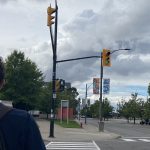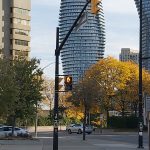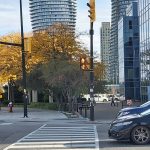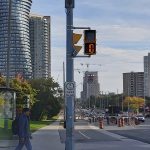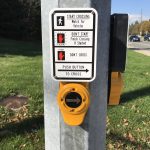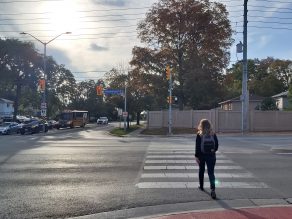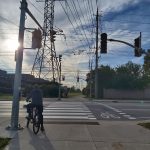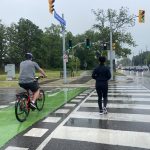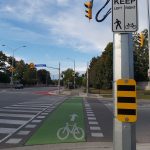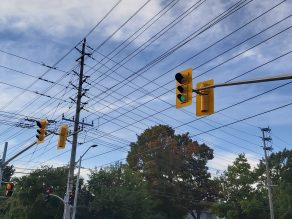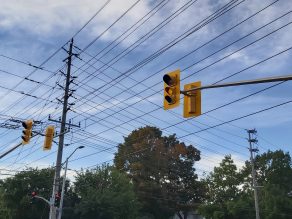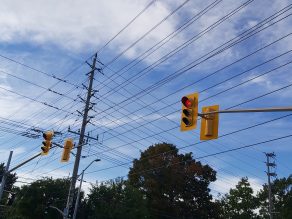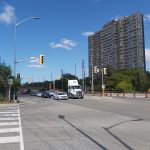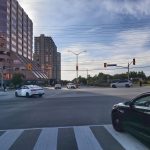Traffic signals
Learn about the different signals that the City’s implementing across Mississauga to promote safer, friendlier streets for all road users. All updates to traffic signals are part of the City’s Vision Zero Action Plan.
Traffic signals for pedestrians
To trigger the walk phase, push the button at the intersection. Only begin crossing the road when the walking person symbol is displayed. The walking person symbol is displayed first, followed by the red flashing hand, and eventually a solid red.
What the symbol means
- The walking person symbol indicates you may cross the road.
- The red hand symbol indicates you may not cross the road.
Do not begin crossing the road when the flashing red hand is displayed. If the walking person symbol turns into the flashing red hand while you’re still crossing, you may finish crossing. You will have enough time before the symbol will change into a solid red hand.
At certain intersections, the flashing red hand will appear along with the countdown timer. This feature is not set up at all traffic lights. The City installs countdown timers at all new traffic lights and on a request basis.
What the symbol means
- The flashing red hand indicates you should not begin crossing the road.
- Countdown timer indicates how many seconds you have left to finish crossing the street.
Accessible pedestrian signals (audible signals) inform pedestrians with visual impairments when and which way to take to cross the road.
What the sound means
- The cuckoo sound indicates you may cross north-south crossings.
- The Canadian Melody sound indicates you may cross east-west crossings.
A pedestrian head start signal gives pedestrians a head start at crossing the road before vehicles. The walking person symbol is displayed five seconds before the green traffic light controlling vehicle traffic is triggered.
Safety benefits of pedestrian head start signals include the following:
- It increases pedestrian visibility for drivers
- It reinforces pedestrian right-of-way over turning vehicles
- It encourages motorists to yield to pedestrians already crossing the road
This signal is also referred to as a Leading Pedestrian Interval (LPI). The City began updating intersections with accessible signals to include the pedestrian head start signal in 2023.
Mid-block pedestrian signals are installed between high-traffic intersections. This allows pedestrians and cyclists to cross the road without needing to travel all the way to the intersection traffic lights.
They include standard traffic signals (green, amber, red lights) to control vehicle traffic on the main street and standard pedestrian walk/flashing and solid don’t walk signals activated by push buttons.
The City installs mid-block pedestrian signals in the following areas:
- Places with a lot of pedestrian activity, such as trail crossings, schools and parks
- Places where uncontrolled mid-block crossing (cutting across the road where there is no traffic control) occurs often
- Places between intersections (with traffic lights) that are far from each other
- Places that enable pedestrians to travel on more direct, efficient routes
Additional benefits of a mid-block pedestrian signal include the following:
- It completes or connects parts of the cycling network
- It improves connection to transit services
Traffic signals for cyclists and e-scooter users
Unless otherwise specified, bicycles and e-scooters are considered vehicles. This means cyclists and e-scooter users need to follow traffic signals for vehicles.
Cyclists and e-scooter users should dismount their vehicles at pedestrian crosswalks. Learn more about cycling rules, regulations and safety tips.
A bicycle signal has three lenses with a stencilled form of a bike that changes from green, yellow and red. At intersections with bicycle signals, cyclists and e-scooter users must obey the signs.
Cyclists don’t need to dismount when using crossrides with bicycle signals installed.
What the colour means
- The green light indicates you may enter the intersection to cross.
- The yellow light indicates you must stop at the stop line if you can do so safely. You must not begin crossing the road when the yellow light is on.
- The red light indicates you must bring your bicycle or e-scooter to a complete stop at the stop line.
Rules and etiquette
All crossride users must follow cycling rules and etiquette, including:
- You must press the pushbutton and wait until the bicycle signal is green before attempting to cross.
- Watch for turning vehicles to be sure the motorist can see you and is yielding.
- Maintain a speed that will allow you stop quickly in case a vehicle turns into your path.
- Don’t pass other users within the crossride.
- If pedestrians are crossing, ring your bell to let them know you are approaching and pass them with caution.
- Obey all signs and signals on site before crossing the intersection.
A bike head start signal gives cyclists a head start at crossing the road before other motor vehicles. The ride signal is displayed five seconds before the green traffic light for motor vehicles is triggered.
Safety benefits of a bicycle head start signal include the following:
- It increases visibility of cyclists in the intersection for drivers
- It reinforces cyclist right-of-way over turning vehicles
- It provides added time for cyclists in need of more time to cross the road
Similar to any other intersection, cyclists are expected to enter the intersection only when the ride signal is showing. Once the yellow signal is activated, you must not begin crossing the road.
In 2023, the City began updating bike signals at intersections where accessible signals are in place to include a bike head start signal.
Traffic signals for vehicles
Green, amber and red lights control vehicle activity on roads and intersections.
What the colour means
- The green light indicates you may turn left, go straight or turn right. When turning left or right on a green light, you must yield to pedestrians, cyclists, and approaching vehicles to avoid a collision.
- The amber light indicates you must stop at the stop line if you can do so safely. Otherwise, proceed with caution for pedestrians already in the intersection and incoming traffic.
- The red light indicates you must bring your vehicle to a complete stop at the stop line. You shall not proceed to drive until the light changes to green and the intersection is clear. A flashing red light may indicate a power outage has occurred. In this case, treat it as an all-way stop.
- A flashing red light may indicate a power outage has occurred. In this case, treat it as an all-way red stop sign.
A fully protected left turn signal controls vehicles turning left at an intersection. It is separate from the traffic light controlling vehicles going straight or turning right.
In these intersections, left-turning vehicles must obey only the fully protected left turn signals.
Fully protected left turn signals can be found installed in intersections with:
- High collision rates involving left turns
- Dual left turn lanes
- Poor horizontal or vertical alignment of the roadway
What the symbol means
- A left-turn green arrow indicates vehicles turning left may proceed.
- If the light turns amber while you are in the intersection, complete your turn with caution.
- When a red light appears on a fully protected left turn signal, vehicles may not turn left, even if there is no incoming traffic. You may not turn left when the green light appears for traffic going straight or turning right.
When the advanced green arrow is displayed, oncoming traffic remains at a complete stop. This allows left-turning vehicles to complete the turn without fear of collision.
The following conditions may trigger an advanced green arrow to appear:
- Time of the day
- Traffic volume
- Road geometrics
What the symbol means
- An advanced green arrow indicates vehicles may turn left.
- If the green light and advanced green arrow are both displayed at the same time, vehicles going straight or turning right may proceed driving.
